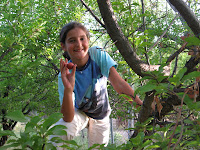 |
| All of us on the beach |
When we got back from our week away, I had an urge to tidy up the attic. I came across some letters and diaries written by my French great-grandfather, Docteur Athanase Linard. He was called up to serve as a doctor in the First World War, and spent the best part of 4 years away from home, traveling from one place to another, setting up field hospitals, or following troops into battle. In the Somme, he was on horseback, at other times and places he traveled by train. He wrote letters - often daily, though we don't have them all - back to his wife Marie, and his three teenage daughters: Genevieve (my grandmother), Jeanne, and Madeleine.
 | ||||
| Interrupted letter |
 |
| Postcard of Kreuznach |
As he says on the 19th Dec from Mainz: "Je fais de l’occupation et j’ai franchi le Rhin en vainqueur comme nos ancêtres il y a cent ans." (Just like our ancestors a hundred years ago, I've crossed the Rhine as a victor and now I'm part of the occupying forces.)
In every letter he refers to his hope of getting leave for Christmas and how much he's looking forward to seeing his daughters. It's not till the 21st that he gives up hope and tells them that he is to be serving at Mainz hospital for Christmas and until he gets demobbed.
On the 26th he writes a long letter home describing how he spent Christmas. This was his day:
 |
| Letter describing Christmas day |
- 10am mass in the cathedral
- 1pm present distribution around the Christmas tree at the hospital for 100 wounded soldiers and 700 liberated french POWs with Mrs Rothschild (pearls the size of cherries in her ears) very busily involved in everything
- lunch for the above in two sittings of 400 each
- 2pm Generals Mangin ("petit, noiraud") and Marchand arrive
- Marseillaise is played
- Film show for everyone











